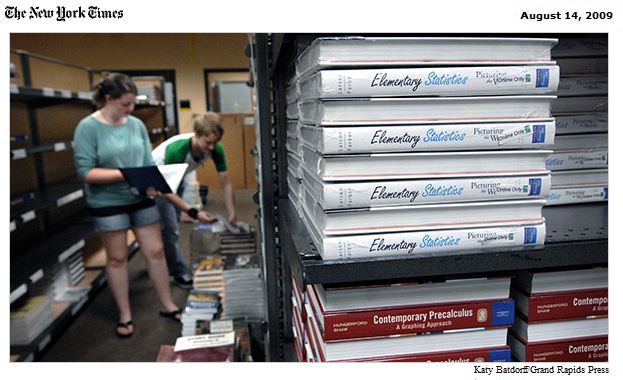So now textbooks for school can be rented in many cases. One question I haven’t heard answered is if the book you rent is already highlighted, is that considered good or bad? It would be handy to know what kinds of grades the previous renter got.
Anyway, I heard about this idea of renting textbooks on National Public Radio Friday morning and thought it would be an interesting subject for a rethinking blog entry, but it seemed a little ho-hum.
I presumed that someone looked at the furniture rental model (which makes no sense for most people because they charge so much, it’s ultimately cheaper to buy it if you rent it for more than 12-18 months in many cases). Books are a little different, but basically if you assume two or three renters, have an efficient book collection model, it’s not too hard to find a price point that works for the publisher and the student.
Then I read this article in the paper by Tamar Lewin and realized there are some really big implications that extend far beyond the book world into lots of other industries. And I will give you the key points that caught my attention:
1) Some publishers are doing the renting themselves, like Cengage Learning, while others, like McGraw-Hill are working with a rental company, Chegg
2) In the case of Cengage, in their model the author gets a royalty for every rental, which doesn’t happen in the McGraw-Hill model because they sell their books to Chegg and Chegg doesn’t have any royalty agreements with authors
3) Then the wild-card is how many years professors are willing to commit to the use of a given textbook. If they won’t agree to at least three years of using the same book, the model doesn’t work, so now there’s a risk that a financial incentive for the schools will influence their decisions about what books are best for their students. That is a little scary
Why do I think that’s so much more interesting than just another rental business? When you have a re-usable asset like this (again somewhat like furniture, software as well in a different sense), and people are thinking about renting it for the first time and experimenting with different models that include royalties and long time contract commitments, it’s very likely that some interesting models as well as best (and worst) practices will emerge. Additionally, because most of these students are young, this segment of the population will enter the workforce with a different notion of buying vs. renting assets.
As we see more use of software-as-a-service and renting software becoming a hotter and hotter topic under the expanding umbrella term “Cloud computing” – I have to believe efforts like this will end up having some effect on the software business both for the customer in terms of what they want and expect, as well as the providers and the manufacturers. Stay tuned on this one.
At least the highlighting isn’t an issue with software. . .
-Ric

Leave a Reply